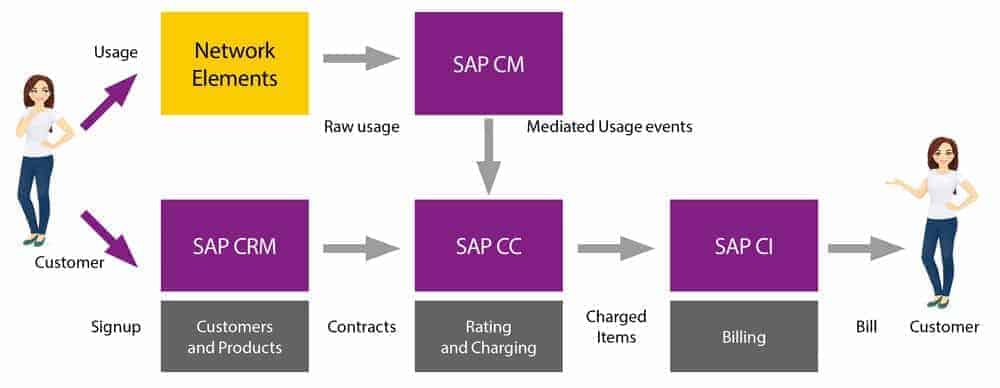Digital service orientation with BRIM


Jasmina Cejan, Principal Consultant at GTW Management Consulting, knows from numerous user projects in which she has implemented SAP BRIM (formerly Hybris Billing):
"Digital technologies are opening up completely new opportunities and business areas on the path from product orientation to service orientation. These in turn require new billing models."
The technological driver for the further development of billing models is the digital transformation, which affects providers and their customers alike.
Digital technologies offer completely new perspectives and business areas. This in turn gives rise to new billing options, which also necessitate a shift from product orientation to service orientation.
The unstoppable change in the field of digital technologies, particularly in information technology, is also changing the traditional consumer world in the long term.
Many business models that have been successfully established for decades have been replaced in a very short space of time. New providers such as Uber, Amazon, Netflix and Lieferando impressively demonstrate the potential of the new digital possibilities.
Value chains are changing
However, not only the business models, but also the value chains are subject to this change. In day-to-day competition, data and information are regarded as crucial resources that determine future profitability. Today, it is much easier for potential customers to obtain information relevant to their purchase than it was years ago.
The internet gives them access to price comparisons or allows them to look at reviews from other customers. However, the new power of the customer has also led to increased competition between providers.
Companies are under increased competitive pressure as they have to respond directly to customers' constantly changing wishes, which are generally decided on the basis of price and the associated services (e.g. postage-free delivery or free exchange).
"Customers usually only accept a higher price if the provider makes up for this with excellent customer service or uncomplicated and flexible billing, for example"
Jasmina Cejan points out.
"Providers can also score points with offers tailored to the individual customer or usage-based billing."
One example of new billing models based on the digital transformation is the sharing economy. Car sharing providers such as Car2Go, e-bike and e-scooter rental companies are now part of the image of a modern city.
The idea behind this is to ensure the best possible availability of a product for the exact period in which it is needed.
In most cases, billing is based on the pay-per-use principle, which transforms the traditional product business into a service business.
"SAP BRIM enables flexible billing at any time, especially for digital services - these can be subscriptions, leasing or usage contracts, one-off fees, consumption and much more"
emphasizes Jasmina Cejan.
"And regardless of whether the unpriced or priced consumption data comes from different source systems, in BRIM it is aggregated on a customer-specific basis and displayed for the customer on an invoice."

Billing and Revenue Innovation
With Billing and Revenue Innovation Management, SAP provides an industry-independent, functional and flexible software solution for pricing, billing and invoicing a wide range of services and products in a standardized system landscape.
The solution can be used to introduce new products or product packages, create standardized invoices, carry out simulations and manage payments and reminders within a short space of time.
BRIM also offers mass data processing, real-time connection and implementation of pre- and post-paid scenarios. The SAP solution offers a high degree of flexibility thanks to its configurability and modularity as well as integration with other SAP modules (e.g. SD, FI-AR, IS-U) and the integration of existing billing systems.
In general, the solution is characterized by this high flexibility and speed: BRIM is designed for mass processes with high transaction volumes and offers better integration with upstream systems that provide the usage transactions.
This makes it easier for companies from a wide range of industries to master upcoming digital challenges or to undergo a digital transformation themselves.
Flexibility and external systems
The entire offer-to-cash business process can be mapped in detail in BRIM - from customer management and product configuration to billing for services used, invoicing and receivables management.
Of course, existing peripheral systems for customer management and rating can also be connected to the SAP BRIM environment in order to map the entire Offer2Cash process with existing systems in a hybrid manner. As the system has a modular structure, individual subcomponents can also be seamlessly replaced.
The most important function of BRIM is the mapping of usage-based or recurring price models for customized offers and the possibility of real-time pricing. In addition to post-paid and pre-paid scenarios, partner participation models can also be implemented.
Customer-centric
The customer or consumer is clearly the focus of BRIM. Companies can respond effectively and create service packages of varying complexity for their customers, for example.
On the other hand, they are also able to evolve quickly in the face of rapid market changes. The habits and personal preferences of customers can also be used for pricing and billing in the sense of big data.
Another major advantage in day-to-day business is that standardized or convergent invoices for services and products can be generated from multiple input channels.
The revenue management chain then supports a high level of consistency throughout the entire receivables management process and efficient management of customers with different credit ratings, right through to handover to the collections department.
In this way, companies increase their profitability, strengthen customer satisfaction and thus also their position on the market.
SAP BRIM is easy to configure and the individual components can be customized according to the company's needs.
Thanks to its modular structure and the seamless integration of other SAP components and upstream billing systems, the solution offers maximum flexibility.
SAP Convergent Charging is used for tariff determination and pricing, while SAP Convergent Invoicing is used for accounting and billing.
Sales and Order Management (as part of SAP CRM) and Customer Financial Management (FI-CA and CRM) round off the offering.
As an agile universal solution, SAP BRIM is used in companies and organizations in sectors such as logistics, telecommunications, media, retail, industry and utilities.
A solution and its history
SAP BRIM has already come a long way: over the years, not only has the solution evolved flexibly and dynamically, but so has its name.
For a long time, the core functionalities of today's universal solution were known as SAP Billing and Revenue Innovation Management (BRIM).
In the original version, conventional billing was created from SD, MM and various industry solutions. The background was to meet the increased technological requirements in terms of data processing speed, data volume to be handled and flexibility (configurable, modular and industry-neutral).
Hybris then joined SAP in 2013. At the time, Hybris was considered one of the leading providers in the e-commerce sector. In 2015, SAP BRIM was finally incorporated into the Hybris family.
From then on, SAP Hybris Billing increasingly focused on customers, their wishes and purchasing experiences. On the other hand, the solution was greatly simplified and thus also made Hana-compatible.
This was done with the help of the Hybris portfolio, consisting of Hybris Commerce, Hybris Cloud for Customer and Hybris Marketing. This led to another name change in 2016:
Hybris software became the SAP Hybris solutions.
In 2018, the final step was taken for the time being: the solutions previously managed under SAP Hybris were brought together with other purchased solutions under the new name SAP C/4 Hana.
The "C" stands for Customer and the four for fourth-generation CRM. With SAP S/4 Hana in the back end and SAP C/4 Hana as a strong front end, SAP is thus pursuing a clear course of effectively and holistically mapping the customer management process. As part of this, SAP Hybris Billing has been renamed again and is now known as SAP Billing and Revenue Innovation Management (SAP BRIM).
The core components of the modular BRIM are:
- SAP Customer Relationship Management (CRM)
- SAP Convergent Mediation by DigitalRoute
- SAP Business Suite (ERP/ECC 6.0) or SAP S/4 Hana with Contract Accounts Receivable and Payable (FI-CA) and Convergent Invoicing (CI) contained therein
- SAP Convergent Charging (CC)





